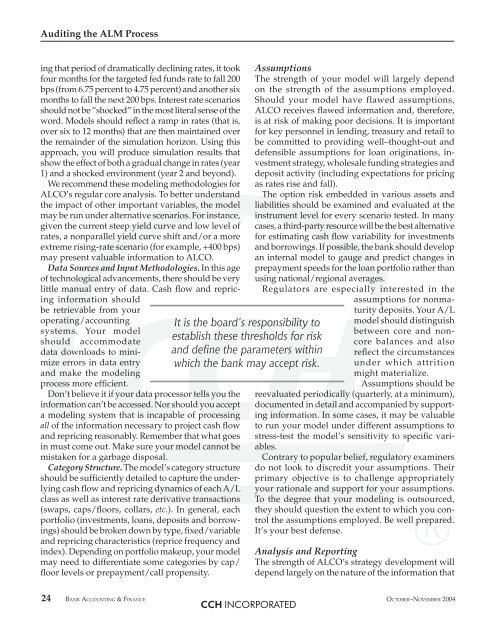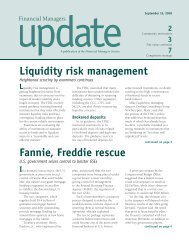The Importance of Auditing the Asset/Liability Management Process
The Importance of Auditing the Asset/Liability Management Process
The Importance of Auditing the Asset/Liability Management Process
You also want an ePaper? Increase the reach of your titles
YUMPU automatically turns print PDFs into web optimized ePapers that Google loves.
<strong>Auditing</strong> <strong>the</strong> ALM <strong>Process</strong><br />
ing that period <strong>of</strong> dramatically declining rates, it took<br />
four months for <strong>the</strong> targeted fed funds rate to fall 200<br />
bps (from 6.75 percent to 4.75 percent) and ano<strong>the</strong>r six<br />
months to fall <strong>the</strong> next 200 bps. Interest rate scenarios<br />
should not be “shocked” in <strong>the</strong> most literal sense <strong>of</strong> <strong>the</strong><br />
word. Models should reflect a ramp in rates (that is,<br />
over six to 12 months) that are <strong>the</strong>n maintained over<br />
<strong>the</strong> remainder <strong>of</strong> <strong>the</strong> simulation horizon. Using this<br />
approach, you will produce simulation results that<br />
show <strong>the</strong> effect <strong>of</strong> both a gradual change in rates (year<br />
1) and a shocked environment (year 2 and beyond).<br />
We recommend <strong>the</strong>se modeling methodologies for<br />
ALCO’s regular core analysis. To better understand<br />
<strong>the</strong> impact <strong>of</strong> o<strong>the</strong>r important variables, <strong>the</strong> model<br />
may be run under alternative scenarios. For instance,<br />
given <strong>the</strong> current steep yield curve and low level <strong>of</strong><br />
rates, a nonparallel yield curve shift and/or a more<br />
extreme rising-rate scenario (for example, +400 bps)<br />
may present valuable information to ALCO.<br />
Data Sources and Input Methodologies. In this age<br />
<strong>of</strong> technological advancements, <strong>the</strong>re should be very<br />
little manual entry <strong>of</strong> data. Cash flow and repricing<br />
information should<br />
be retrievable from your<br />
operating/accounting<br />
systems. Your model<br />
should accommodate<br />
data downloads to minimize<br />
errors in data entry<br />
and make <strong>the</strong> modeling<br />
process more efficient.<br />
Don’t believe it if your data processor tells you <strong>the</strong><br />
information can’t be accessed. Nor should you accept<br />
a modeling system that is incapable <strong>of</strong> processing<br />
all <strong>of</strong> <strong>the</strong> information necessary to project cash flow<br />
and repricing reasonably. Remember that what goes<br />
in must come out. Make sure your model cannot be<br />
mistaken for a garbage disposal.<br />
Category Structure. <strong>The</strong> model’s category structure<br />
should be sufficiently detailed to capture <strong>the</strong> underlying<br />
cash flow and repricing dynamics <strong>of</strong> each A/L<br />
class as well as interest rate derivative transactions<br />
(swaps, caps/floors, collars, etc.). In general, each<br />
portfolio (investments, loans, deposits and borrowings)<br />
should be broken down by type, fixed/variable<br />
and repricing characteristics (reprice frequency and<br />
index). Depending on portfolio makeup, your model<br />
may need to differentiate some categories by cap/<br />
floor levels or prepayment/call propensity.<br />
It is <strong>the</strong> board’s responsibility to<br />
establish <strong>the</strong>se thresholds for risk<br />
and define <strong>the</strong> parameters within<br />
which <strong>the</strong> bank may accept risk.<br />
Assumptions<br />
<strong>The</strong> strength <strong>of</strong> your model will largely depend<br />
on <strong>the</strong> strength <strong>of</strong> <strong>the</strong> assumptions employed.<br />
Should your model have flawed assumptions,<br />
ALCO receives flawed information and, <strong>the</strong>refore,<br />
is at risk <strong>of</strong> making poor decisions. It is important<br />
for key personnel in lending, treasury and retail to<br />
be committed to providing well–thought-out and<br />
defensible assumptions for loan originations, investment<br />
strategy, wholesale funding strategies and<br />
deposit activity (including expectations for pricing<br />
as rates rise and fall).<br />
<strong>The</strong> option risk embedded in various assets and<br />
liabilities should be examined and evaluated at <strong>the</strong><br />
instrument level for every scenario tested. In many<br />
cases, a third-party resource will be <strong>the</strong> best alternative<br />
for estimating cash flow variability for investments<br />
and borrowings. If possible, <strong>the</strong> bank should develop<br />
an internal model to gauge and predict changes in<br />
prepayment speeds for <strong>the</strong> loan portfolio ra<strong>the</strong>r than<br />
using national/regional averages.<br />
Regulators are especially interested in <strong>the</strong><br />
assumptions for nonmaturity<br />
deposits. Your A/L<br />
model should distinguish<br />
between core and noncore<br />
balances and also<br />
reflect <strong>the</strong> circumstances<br />
under which attrition<br />
might materialize.<br />
Assumptions should be<br />
reevaluated periodically (quarterly, at a minimum),<br />
documented in detail and accompanied by supporting<br />
information. In some cases, it may be valuable<br />
to run your model under different assumptions to<br />
stress-test <strong>the</strong> model’s sensitivity to specific variables.<br />
Contrary to popular belief, regulatory examiners<br />
do not look to discredit your assumptions. <strong>The</strong>ir<br />
primary objective is to challenge appropriately<br />
your rationale and support for your assumptions.<br />
To <strong>the</strong> degree that your modeling is outsourced,<br />
<strong>the</strong>y should question <strong>the</strong> extent to which you control<br />
<strong>the</strong> assumptions employed. Be well prepared.<br />
It’s your best defense.<br />
Analysis and Reporting<br />
<strong>The</strong> strength <strong>of</strong> ALCO’s strategy development will<br />
depend largely on <strong>the</strong> nature <strong>of</strong> <strong>the</strong> information that<br />
24 BANK ACCOUNTING & FINANCE OCTOBER–NOVEMBER 2004





